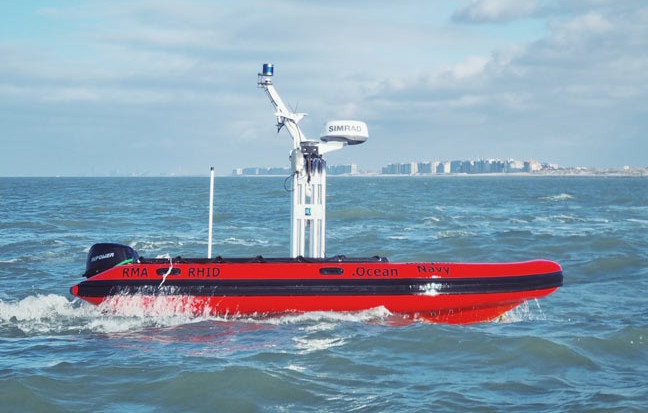Enabling operations with multiple heterogeneous unmanned maritime assets
- Project Code: MarSur
- Start Date: October 1, 2018
- End Date: December 31, 2023
- Reference: DAP 19/08
- Funding: Royal Higher Institute for Defence (RHID)
- Royal Military Academy Involvement: Director

Team
- Coordinator: Geert De Cubber
- Coordinator Affiliation: Royal Military Academy, Department of Mechanics (MECA)
- Project Co-promotor: Rob Haelterman
- RMA Researchers: Benoît Pairet (MECA)
- Project Partners (RMA): Department of Mathematics (MWMW)
- Project Partners (BE-DEF): Belgian Navy
- Project Partners (Other): dotOcean
Context
Unmanned maritime vehicles are more and more becoming important assets for military operations, not only on the battlefield, but also in logistics and in supportive roles. This also means that more and more of these vehicles are being deployed in the field, each with their own characteristics and specifications. This variety poses interoperability problems when deploying these assets together for operations, as there is to date no unified command structure for these unmanned assets and there are also no standardized data interchange platforms that allow for an easy transfer of sensory information from one platform to another. The result is that field commanders have to work in most circumstances with custom-built solutions that may be good in performing one task well, but that encompass little flexibility and modularity towards upgrading the task description for future needs or towards interoperability with other deployed assets. This study proposal aims to remedy that situation by developing an interoperability concept for heterogeneous unmanned assets that allows for the seamless integration of these tools into existing standard operating procedures.
Interoperability is the key that acts as the glue among the different units within the team, enabling efficient multi-robot cooperation. Seamless and non-ambiguous interaction between different robots of any provider and domain demands a common, well-defined interface. The ultimate goal of the work on the heterogeneous team is to consolidate a common command, control and payload interface to be agreed and adopted by all robotics platforms and control stations involved in an operation. This approach provides a common framework for the development of collaborative unmanned assets, minimizing the integration time and costs by avoiding ad-hoc implementations.
As a key concept, we develop a heterogeneous interoperability and collaboration framework which is seamlessly interoperable with the existing and future C4I and GIS infrastructure. The interoperability concept consists of a highly modular system of carrier platforms and sensor payloads, enabling straightforward switching of payloads from one system to another. This modular architecture will also ensure the future exploitability of the results of this project on other assets after the end of the project.
In terms of validation, three use cases are under preparation, each geared at a different application domain to maximize the exploitation potential of the IP developed within this study and to validate the proposed interoperability concept in a wide range of applications:
- Shared situational awareness and data traffic management for unmanned dredging vessels This is fits in a VLAIO – Blue Cluster research and innovation project (SSAVE) studying the data management, cybersecurity and interoperability questions that are posed when (unmanned) assets start to exchange data on all levels (not only towards the cloud, but also between the edges). Preparatory work has been performed this year on unmanned surface vessels navigating autonomously within the port of Antwerp.
- Maritime surveillance of offshore windmill parks Within the scope of this validation use-case an off-shore windmill park has been outfitted with technology (hardware and software) to automatically detect trespassing vessels.
- Unmanned mine counter measures This validation use case fits into the much larger PESCO-MAS-MCM framework and is still under preparation.
Objectives
TODO
Methodology
TODO